Catherine Savard
On the Waterfront
St. Terry of Palukaville
Marlon Brando gives the performance of a lifetime as longshoreman, Terry Malloy, in “ On the Waterfront”.
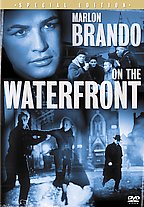
On the Waterfront Video Trailer
I heard a good sermon the other Sunday. I wasn’t even in church at the time. In fact, it happened in the wee hours of the morning on Saturday night, when it was just barely Sunday. No, I wasn’t downloading sermons from my favourite preacher off the Internet and, no, I wasn’t watching Benny Hinn on late night television. I was sitting in my kitchen listening to a powerful homily captured on celluloid as delivered by a rather obscure Catholic priest, Father Barry (well, actually Karl Malden playing Father Barry).
Some of the exegesis in the middle section of the message was a bit wonky, but overall it was a sermon that packed a powerful punch – much better than average - and I’ve heard a lot of average or worse than average sermons in my day. I’ve also been privileged to hear some of the best preachers in the business. The “Crucifixion” speech by Father Barry after the murder of Kayo Dugan in On the Waterfront contained some key elements of a really good sermon: audience preparation, an attention-getting lead, carefully shaped wording, an appropriate key text (See verse. 40), an in-depth understanding of the needs of the parishioners and a clear take-home point.
The Father Barry character was lucky to have a professional screenplay writer, Budd Schulberg, backing him up. Just how Budd Schulberg got into the business of writing Father Barry’s sermons is a bit of a complicated process (see Tim Dirks for a lucid explanation of the story), but, just like the rest of this film, it seems to work, even after fifty odd years have gone by. Equally complicated is the story of how the director, Elia Kazan, came to make the movie about becoming a whistle-blower before a congressional crime commission after himself being a key witness at the infamous House Un-American Activities Commission. Some regard the film as an expiatory act for Kazan ’s participation in the commission’s witch-hunt.
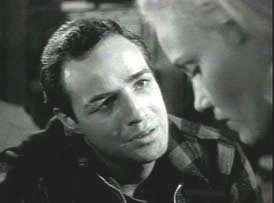 No matter how it got here, On the Waterfront remains a masterpiece of the cinematic art form. They don’t make’em like that anymore.
No matter how it got here, On the Waterfront remains a masterpiece of the cinematic art form. They don’t make’em like that anymore.
Brando’s performance as Terry Malloy, a washed-up prize fighter owned by a two-bit racketeer, Johnny Friendly, was masterful. Brando is at the height of his cinematic career in this film. Brando manages to capture the tough guy façade , the pathos of the longshoreman’s situation, and the cadences of the accent. In this tour de force, Brando manages to put it all across in a sympathetic way.
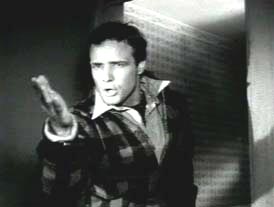 Unlike the young actor who followed in his footsteps, Jimmy Dean, Brando’s life and career did not end in a spectacular ball of fire. Both actors achieved remarkable success by the mid ‘50s, but after a few more good years, there was a downturn for Brando. “Mourir à petit feu” appears to have been Marlon’s fate in real life and in his career. He died in 2004 at 80 of pulmonary fibrosis, a grotesque disease that gradually suffocates the sufferer to death in the final stages. Not a good ending.
Unlike the young actor who followed in his footsteps, Jimmy Dean, Brando’s life and career did not end in a spectacular ball of fire. Both actors achieved remarkable success by the mid ‘50s, but after a few more good years, there was a downturn for Brando. “Mourir à petit feu” appears to have been Marlon’s fate in real life and in his career. He died in 2004 at 80 of pulmonary fibrosis, a grotesque disease that gradually suffocates the sufferer to death in the final stages. Not a good ending.
I found Jim Englund’s remarks during the Interviews about Brando as an actor to be particularly revelatory. Englund talked about his understanding of Marlon both from the point of view of a director and as a personal friend.
Englund spoke about how Brando continued to act after he was past his prime because, like Sugar Ray Robinson, he was the best at what he did. He knew how to fight dirty and still win. Englund went on to say that, “(Brando) didn’t have any of the verities to help him, the sense of well being in oneself from being an honourable person with oneself and with others. He was denied that. You can’t blame him. It was the circumstances, the anthropology of his life. He hadn’t been prepared for that.”
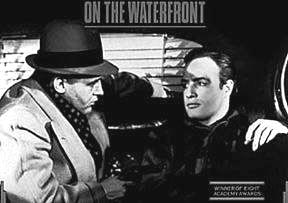 Perhaps Brando the actor was more like the character of Terry Malloy than we might guess. Terry, with his rather “rough and tumble” upbringing, has not been well prepared for the exigencies that face him in the aftermath of Joey Doyle’s murder. He has none of the “verities” that are necessary for facing up to web of crime and corruption other than a form of raw courage and a spirit of independence.
Perhaps Brando the actor was more like the character of Terry Malloy than we might guess. Terry, with his rather “rough and tumble” upbringing, has not been well prepared for the exigencies that face him in the aftermath of Joey Doyle’s murder. He has none of the “verities” that are necessary for facing up to web of crime and corruption other than a form of raw courage and a spirit of independence.
Terry doesn’t have a conscience that has undergone “strength training” through being shaped by the church or any other “civilizing” agent. He has only ever known the law of the jungle: “Do it to them before they do it to you!” Terry eventually realizes that his brute physical strength as a boxer and his present approach to life are inadequate to meet the challenge. Terry fumbles his way to a new way of meeting the challenge with the aid of Father Barry and Edie Doyle.
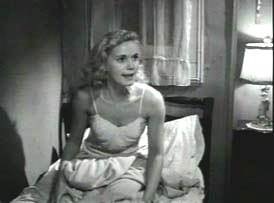 As Terry Malloy walks into the courtroom in an ill-fitting suit, the bailiff plops his hand awkwardly on the Bible to be sworn in: “Do you swear to tell the truth, the whole truth, and nothing but the truth?” – “Yeah, right.” Nothing comes naturally to Terry in this whole new arena of combat. He may not have the moves down, but in the end Terry follows through and wins the day.
As Terry Malloy walks into the courtroom in an ill-fitting suit, the bailiff plops his hand awkwardly on the Bible to be sworn in: “Do you swear to tell the truth, the whole truth, and nothing but the truth?” – “Yeah, right.” Nothing comes naturally to Terry in this whole new arena of combat. He may not have the moves down, but in the end Terry follows through and wins the day.
After the court scene, Terry is faced with yet another challenge; the harsh reality that he has only won the first round of what is to be a marathon battle. There are costs to pay as the newly minted saint begins to work out the meaning of perseverance. Terry’s pet pigeon’s have been poisoned. He finds himself excluded both from his livelihood and from the only society he knows on the docks.
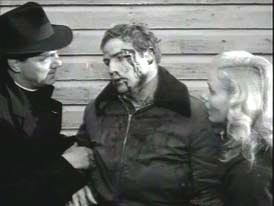 In the final climactic scene of the film, Terry has a showdown with his nemesis, Johnny Friendly. First, Terry uses verbal taunts and his fists to show Johnny that he has no regrets for his defiance. This approach results in a lot of mangled facial features and some very sore ribs. Father Barry comes along. As the pastor who has come out of his church and down to the docks to be where the common folk are, Father Barry then exercises the critical role of moral guide and fight coach. Battered and bruised, Terry gets up from the half sunk dock, walks the Via Dolorosa, and wins the moral victory for the freedom of his fellows. An unexpected miracle takes place. The power of the mob has been broken.
In the final climactic scene of the film, Terry has a showdown with his nemesis, Johnny Friendly. First, Terry uses verbal taunts and his fists to show Johnny that he has no regrets for his defiance. This approach results in a lot of mangled facial features and some very sore ribs. Father Barry comes along. As the pastor who has come out of his church and down to the docks to be where the common folk are, Father Barry then exercises the critical role of moral guide and fight coach. Battered and bruised, Terry gets up from the half sunk dock, walks the Via Dolorosa, and wins the moral victory for the freedom of his fellows. An unexpected miracle takes place. The power of the mob has been broken.
In this day and age, it all seems like a fairy tale. Good winning out over evil. Lofty ideals and exhortations uttered with no apology. Films like this don’t get made today, at least not with the subtext supplied by the Father Barry figure as provided by his sermon writer, Budd Schulberg. Because of this, I find that the film plays more like a historical artefact even though much of the emotional authenticity remains intact for today’s audience.
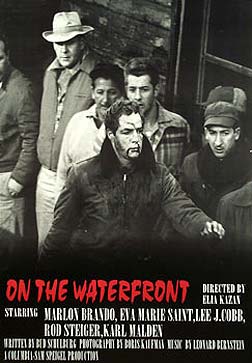 But what about the fact that the premise for this film was based on actual court cases and real people who really did exist? Things might not have been exactly as depicted in the film, but there were actual events that led to breaking up the hold of the mob on longshoremen at a certain place at a certain period of time in American history. “On the Waterfront” might be a modern day fairy tale, but that does not change history.
But what about the fact that the premise for this film was based on actual court cases and real people who really did exist? Things might not have been exactly as depicted in the film, but there were actual events that led to breaking up the hold of the mob on longshoremen at a certain place at a certain period of time in American history. “On the Waterfront” might be a modern day fairy tale, but that does not change history.
And what about the whole saint making mythology? Was Terry Malloy really a changed man? Was he really on his way to being a saint or was he just duped into doing the bidding of a new set of more sophisticated but equally unscrupulous masters? Was Terry a free man or an exploited fall guy?
I think that such questions and such a cynical perspective on this film belongs more to this age – the age of the “Da Vinci Code” – than to the original intent of this 1950’s film.
A little while ago I was listening to a radio interview on the CBC of a Zimababwean political activist who publicly opposes the dictator, Robert Mugabe. After discussing many of the complex political issues involved in the very messy and longstanding Zimababwe situation, the interviewer asked this well-spoken and obviously very educated African man if he feared for his life after Mugabe had made public threats against him. The answer was “no”. (Not that the protestor was persuaded that Mugabe could not or would not undertake such an act in order to silence him.)
The interviewer also cited the activist’s own words and asked how he could reconcile his stance of non-violent protest with the fact that he has stated that he prays regularly that Mugabe would “die and be taken out of office”. The activist, a devout Roman Catholic, explained that there was no essential contradiction in these two positions. Although he believes completely in non-violent means of change, he also thinks it is a responsibility for him as a Christian to actively petition a sovereign and just God to remove a corrupt dictator by death through some other agency.
The Roman Catholic Church is still in the saint making business. Saints aren’t impotent statues smiling down benignly from a lofty pedestal. They are and always have been real people who rise up to face the challenges of real life with out –of-the-ordinary courage and strength.
Whether Terry Malloy has really become a saint or not is a question that is never answered. We never see the next chapter in order to find out what Terry actually does with his life. This is extraordinarily important as far as the saint making business is concerned because the perseverance of the saints is everything. But hey! This is Hollywood ! These guys are in the movie making business after all!
Suggested Links:
- Up close and personal with Marlon Brando: IMDb mini biography
- The Via Dolorosa: catch the original on video. You Tube
- “I could’ve been a contender! I could’ve been a somebody instead of a bum!”: strength within from a solid self image
- The Age of the “Da Vinci Code”: selective cynicism
- Johnny Friendly was calling the shots for Terry Malloy. Who's running your show?



